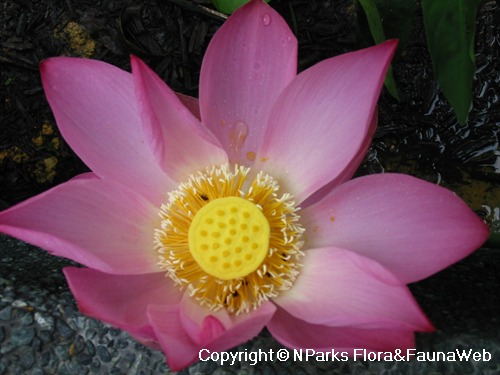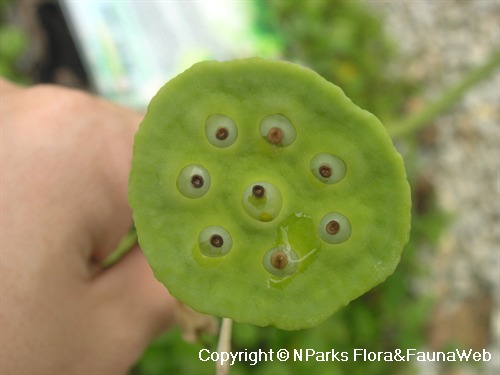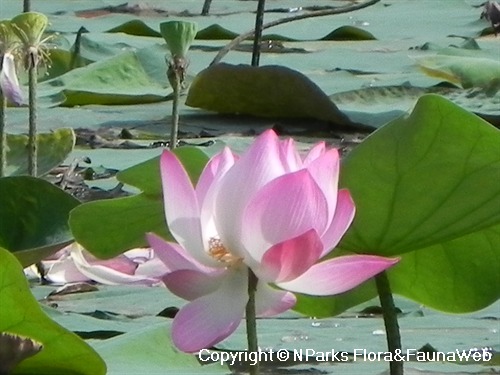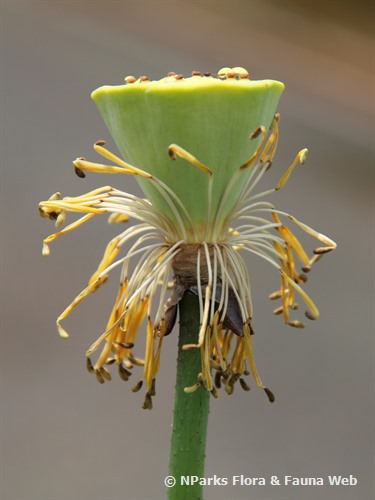
Back
Nelumbo nucifera
| Family Name: | Nelumbonaceae |
| Common Name: | Lotus, Teratai, Sacred Lotus, East Indian Lotus, 莲, 荷花 |
Often found growing out of the mud in freshwater ponds, the Lotus (Nelumbo nucifera) is a culturally significant plant in Asia. Most parts of the Lotus are edible, including the flowers, leaves and seeds. The seeds can be made into lotus seed paste, an ingredient in mooncakes; a Chinese pastry eaten during the Mid-Autumn Festival.
Name
Classifications and Characteristics
| Plant Division | Angiosperms (Flowering Seed Plants) (Dicotyledon) |
|---|---|
| Plant Growth Form | Aquatic & Hydrophyte |
| Lifespan (in Singapore) | Perennial |
| Mode of Nutrition | Autotrophic |
Biogeography
| Native Distribution | Asia and northeast Australia. |
|---|---|
| Native Habitat | Aquatic (Freshwater Pond / Lake / River) |
| Preferred Climate Zone | Tropical |
| Local Conservation Status | Non-native (Spontaneous (Casual)) |
Description and Ethnobotany
| Foliage | The large, peltate (with the leaf stalk attaching to the centre) leaves(60 cm across) rise above the water surface on 1-2 m long petioles. |
|---|---|
| Stems | The underground horizontal stem (known as a rhizome) occurs in the mud at the bottom of shallow ponds. |
| Flowers | Large flowers (35 cm wide) are usually found on thick stems rising several centimeter above the leaves. |
| Fruit | Develops above water. A conical struture with seeds, each in its own socket. |
| Habitat | Nelumbo nucifera found in warm temperate to tropical climates, in a range of shallow wetland habitats, including floodplains, ponds, lakes, pools, lagoons, marshes, swamps and the backwaters of reservoirs. |
| Ethnobotanical Uses | Edible Plant Parts : Edible Fruits, Edible Leaves, Edible Flowers, Edible Stems, Edible Seeds, Edible Roots, Edible Storage Organs Food (Fruit or Vegetable): The young leaves, leaf stalks and flowers are eaten as vegetables. The "roots" (rhizomes) are used as a vegetable in soups, stir-fried. Young lotus stems are used as a salad ingredient. The lotus seeds (called lian zi in Chinese) can be eaten raw or dried and popped like popcorn. They can be boiled with dried longans to make a dessert., or made into a paste. Lotus seed paste is the most common ingredients used in pastries such as mooncake and rice flour pudding. The large leaves are used to wrap food such as in lotus rice. (Herb or Spice): The stamens are dried and made in to herbal tea called lianhua cha in Chinese. Medicinal: The entire plant is used medicinally the Chinese. The plant itself is prescribed as an antidote for mushroom poisoning. The rhizomes or leaves are used with other herbs to treat sunstroke, fever, diarrhoea, dysentery, dizziness, vomiting of blood, hemorrhoids. The embryonic seeds for high fever, cholera, nervous disorders and insomnia; the seeds to stop vomiting, relieve indigestion and diarrhoea or just as a tonic. The flower stalks are used for excessive bleeding from uterus. Seeds are used as tonic. |
Landscaping Features
| Desirable Plant Features | Ornamental Flowers, Fragrant |
|---|---|
| Landscape Uses | Pond / Lake / River |
| Thematic Landscaping | Water Garden |
Plant Care and Propagation
| Light Preference | Full Sun |
|---|---|
| Water Preference | Lots of Water |
| Plant Growth Rate | Moderate |
| Rootzone Tolerance | Waterlogged Soils |
| Soil pH Range From | 5.5 |
| Soil pH Range To | 7.5 |
| Propagation Method | Seed, Division |
Foliar
| Mature Foliage Colour(s) | Green, Green - Bluish Green |
|---|---|
| Mature Foliage Texture(s) | Papery, Rough |
| Foliar Type | Simple / Unifoliate |
| Foliar Shape(s) | Non-Palm Foliage (Orbicular / Round) |
| Foliar Margin | Entire |
| Leaf Area Index (LAI) for Green Plot Ratio | 4.5 (Shrub & Groundcover - Dicot) |
Non - Foliar and Storage
| Specialised Storage Organ(s) | Underground (Rhizome) |
|---|
Floral (Angiosperm)
| Flower Colour(s) | Pink |
|---|---|
| Flower Grouping | Solitary |
| Flower Location | Terminal |
| Flowering Period | Free-Flowering |
Fruit, Seed and Spore
| Mature Fruit Colour(s) | White |
|---|---|
| Seed Quantity Per Fruit | Numerous (>20) |
Image Repository
Others
| Master ID | 963 |
|---|---|
| Species ID | 2257 |
| Flora Disclaimer | The information in this website has been compiled from reliable sources, such as reference works on medicinal plants. It is not a substitute for medical advice or treatment and NParks does not purport to provide any medical advice. Readers should always consult his/her physician before using or consuming a plant for medicinal purposes. |












